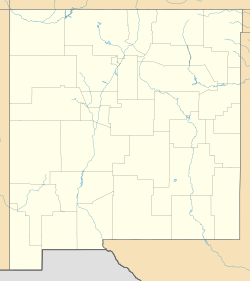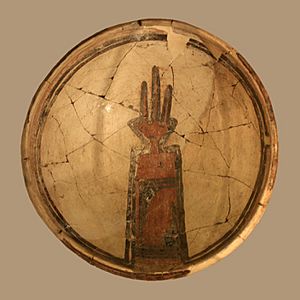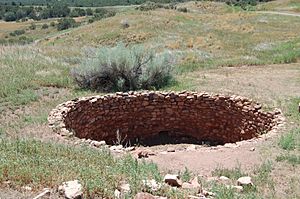Pecos National Historical Park facts for kids
|
Pecos National Historical Park
|
|

Pecos Pueblo Mission Church
|
|
| Location | NM 63 SW of jct. with NM 50, Pecos, New Mexico |
|---|---|
| Area | 6,671.4 acres (2,699.8 ha) |
| Built | Start date ~A.D. 1300 |
| Architectural style | Stone Masonry w/adobe mortar |
| Visitation | 43,873 (2011) |
| Website | Pecos National Historical Park |
| NRHP reference No. | 66000485 (original) 91000822 (increase) |
Quick facts for kids Significant dates |
|
| Added to NRHP | October 15, 1966 |
| Boundary increase | July 2, 1991 |
| Designated NHL | October 9, 1960 |
| Designated NMON | June 28, 1965 |
| Designated NHP | July 2, 1991 |
Pecos National Historical Park is a special place in New Mexico, USA. It is managed by the National Park Service. This park covers thousands of acres. It holds many historical treasures. These range from ancient ruins to 19th-century ranches. It even includes a battlefield from the American Civil War.
The most important part of the park is Pecos Pueblo. It is also known as Cicuye Pueblo. This was once a large Native American community. It was left empty a long time ago. Pecos was first a state monument in 1935. It became Pecos National Monument in 1965. Then, in 1990, it grew much larger and got its current name. Two areas in the park, the pueblo and the Glorieta Pass Battlefield, are recognized as National Historic Landmarks.
Contents
Exploring Pecos National Historical Park
Pecos National Historical Park is in western San Miguel County. It is about 17 miles (27 km) east of Santa Fe. It is also just south of the town of Pecos.
The Ancient Pecos Pueblo
The main part of the park protects the ruins of Pecos Pueblo. This pueblo was historically called Cicuye. Its name meant "village of 500 warriors." The first Pecos pueblo was built around AD 1100. It was one of about two dozen villages made of rock and mud. These were built in the valley during the Pueblo II Era.
Over 350 years, the Pecos village grew very large. During the Pueblo IV Era, it housed more than 2,000 people. They lived in a complex with five stories. The people of Cicuye/Pecos Pueblo spoke the Towa language. They had a rich culture. They were known for their clever buildings and beautiful crafts.
Their religious life was also very important. We know this from the remains of over 20 ceremonial underground rooms called kivas. Some kivas were as wide as 40 feet (12 meters). They were 10 feet (3 meters) deep. People used wooden ladders to enter them. Farming was a big part of their food supply. They grew beans, corn, and squash.
Pecos was a major trading hub. Its location and power helped connect the Pueblo people with Plains cultures. Groups like the Comanche traded goods there. The Pecos people lived in this area for a very long time. Their history goes back to the Preceramic Period (11,500 BCE - 600 CE).
Over time, the Pecos community faced many challenges. Some people moved to other areas. New settlers moved into the region. There were also new diseases and conflicts with other groups. These issues caused the community to shrink. The last 17 (or 20) people left Pecos Pueblo in 1838. They moved to the Jemez Pueblo. This was the only other pueblo that spoke the Towa language.
The Pecos people made and traded seven types of pottery. These included Rio Grande Greyware and Rio Grande Glaze Ware. Many pieces were decorated with colorful designs.
The Spanish Mission
The park also protects the remains of a Spanish mission. It was called Mission Nuestra Señora de los Ángeles de Porciúncula de los Pecos. This mission was built near the pueblo in the early 1600s.
You can walk a 1.25-mile (2 km) trail. It starts at the visitor center. The trail goes through the ruins of Pecos Pueblo and the mission church. Spanish explorers led by Francisco Vásquez de Coronado visited Pecos in 1540. The Spanish mission church was built in 1619.
In 1680, the Pueblo people rebelled. They built a traditional kiva in front of the church. This showed they wanted to keep their own traditions. When the Spanish returned in 1692, the Pecos people remained friendly. A new, smaller church was built in 1717.
Forked Lightning Ranch
Another interesting part of the park is the Forked Lightning Ranch. This was a cattle ranch started in the 1920s. It was founded by Tex Austin, a famous rodeo producer. The ranch headquarters was at Kozlowski's Stage Stop and Tavern. This was an old stop on the Santa Fe Trail. It was also a camp for Union soldiers before the Battle of Glorieta Pass.
Tex Austin later turned the ranch into a "dude ranch." This was a place where people from cities could experience ranch life. The main ranch house was designed by John Gaw Meem. It was built in the Pueblo Revival style. Austin's ranch eventually closed in 1933.
In 1936, it became a working cattle ranch again. In 1941, Buddy Fogelson bought it. He was a Texas oilman. He married the famous actress Greer Garson. After her husband passed away, Garson sold her part of the ranch in 1991. A conservation group bought it and gave it to the National Park Service.
The Old Santa Fe Trail
Parts of the historic Santa Fe Trail run through the park. This old wagon trail was very important. It was a main route for growth in the American Southwest during the 1800s.
Glorieta Pass Battlefield
The Battle of Glorieta Pass happened from March 26–28, 1862. It was fought in the mountain pass west of Pecos Pueblo. This was along the route of the Old Santa Fe Trail. Confederate soldiers were trying to capture Fort Union. Union forces from New Mexico and Colorado fought them. The battle ended in a draw.
Some parts of the battlefield have been changed by highway building. But two sections are protected by the Park Service. These are on either side of the pass. Public access to these areas is limited.
Park History
Pecos Pueblo and 341 acres (138 ha) of land became a state monument in 1935. In 1965, President Lyndon Johnson made it Pecos National Monument. The Park Service then took control. In 1990, the park grew to over 6,000 acres (24 km2). This included a large area of ranchland and important archaeological sites. The two parts of the Glorieta Pass Battlefield were added to the park in 1993.
See also






